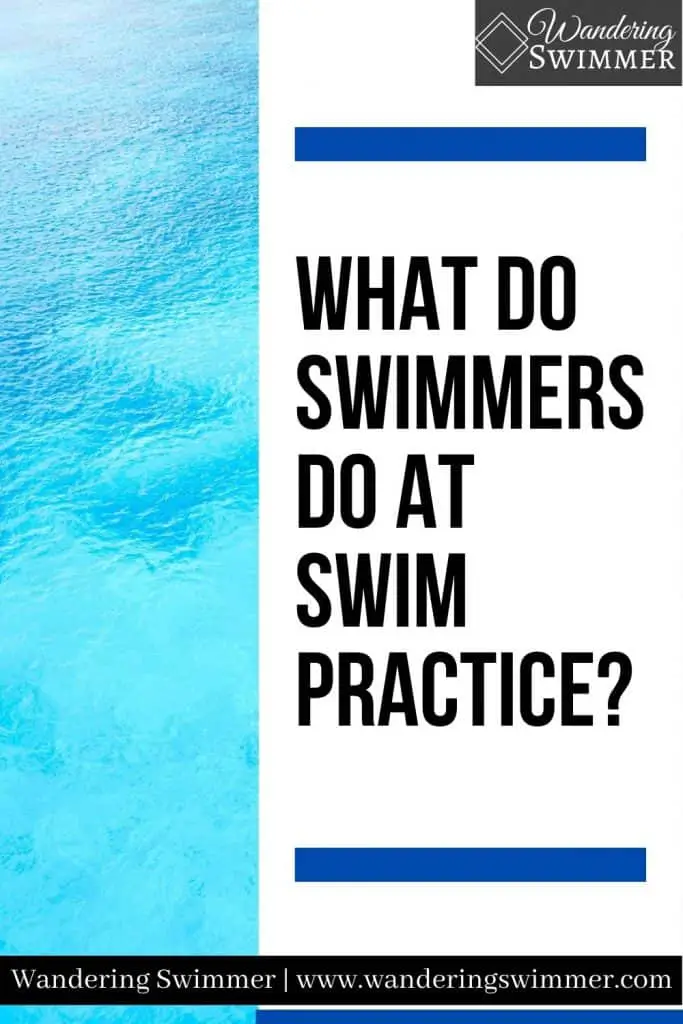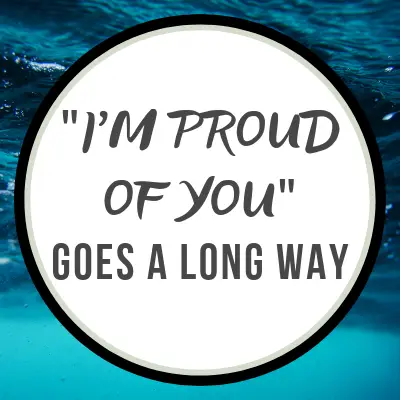If you’re considering joining a swim team or getting ready to start swimming, you might wonder what swimmers do at swim practice.
Swim practice is more than just swimming laps for swimmers. It’s long hours spent at the pool, working on techniques, endurance, and sprint work. But practices aren’t limited to just time spent in the water.
Related article: Swimming Secrets: What Really Happens at Swim Practice
While at their core they’re simple, they also consist of many different layers that build into the overall workout. Here are some things that swimmers do at swim practice.
Disclosure: This post may contain affiliate links, meaning we earn a small commission at no cost to you if you purchase something through one of our links. As an Amazon Associate, we earn from qualifying purchases. Please check out our disclosure page for more information.

Stretch
Some swim teams have stretch time built into their practice. While other teams it’s up to the swimmer to stretch on their own.
And although most people don’t realize that swimmers should stretch before practice, it’s incredibly important that they do. Stretching – for any sport or activity – helps prevent injury.
More Content for You: What Should You Bring to Your First Swim Practice?
It might be a low impact sport, but it’s highly repetitive in its motions. Because of this, swimmers must stretch out their shoulders well before practice starts. This involves dynamic stretching, band work, and even some light lifting.
Swimmers also stretch to work on their flexibility. Staying flexible can also help prevent injuries and aid in swimming.
Dryland
Despite its name, swim practice isn’t just about swimming. Swim practice also consists of dryland.
‘Dryland’ is swimmer’s talk for weight and strength conditioning. While swimming is a great way to build cardio endurance, have a low impact workout, and lose weight, swimming alone doesn’t build much muscle.
Related article: What is Dryland?
To counter this, swimmers have dedicated practices or time during practice to hit the weight room. Lifting weights and doing countless core workouts is a large part of swim practice.
During dryland, coaches can have their swimmers do other forms of cardio. This can range from jump rope to running stadiums.
The time spent in the weight room does differ per team. Just as some coaches require that their swimmers do dryland and others make it optional. Swimmers can also do dryland at home, if they can’t make a dryland workout.
For younger swimmers joining a swim team, dryland will consist of more bodyweight exercise. Push-ups, sit-ups, and planks. Children just starting on swim teams will rarely do any type of dryland, except for core work.
Train
At its core, swimmers train during practice. What a swimmer trains for varies by each swimmer and their goals. Some swimmers train to make college teams and others train so they can earn National cuts.
Some train for both!
And yes, some train for the Olympics, even if only a small percent will make it.
No matter what a swimmer trains for though, swim practice is the place where swimmers build and hone their skills to reach that goal.
More Content for You: 5 Things to Know Before Joining a Swim Team
Swim practice is more than swimming laps in a pool. It’s chasing the clock to see how fast you can go. And how long you can hold that pace. It’s working on technique and trying to maintain the fine movements even when going as fast as you can.
Here are some things that swimmers work on in the pool during swim practice.
Warm-up/cool-down
Part of swim practice is warming up and cooling down. Much like any other sport. Even though swimmers stretch before (and after practice), they still need to warm-up and cool down during practice.
This period of practice varies by team. With some teams following a long warm-up with various sets before getting to the main workout. While others have a shorter warm-up and jump straight into the workout itself.
Swim Sets
In swimming, sets refer to the various workouts done during practice. This can be the main workout itself and it can also be smaller drills, kick, and technique sets throughout the entire workout.
Again, this varies greatly by coach and by the team.
Some coaches have 1-2 main sets with several smaller sets in between. While other teams might train one long workout that takes the entirety of practice. And some teams might do one large set built upon numerous sets built into it.
Related article: 30 Words to Get You by at Swim Practice
Sets typically focus on something particular. Such as distance, sprint, or specialty work. Or it can be a combination, such as a sprint specialty. Some sets focus strictly on breath control and others are strictly focused on kicking.
One of the main pieces of a swim set is an interval, which can dictate how fast a swimmer needs to go. And how much rest they can get. Bet you didn’t think that swimming had math in it!
An example of an interval is a 100 freestyle on 1:15. If a swimmer finishes their 100 freestyle in 1:10, they’ll get five seconds rest. If they finish at 1:00, then they get fifteen seconds rest.
It seems easy with the single 100 freestyle example. But swimmers will go through this a dozen times with varying distances and strokes. And while they’re watching the clock and calculating the time, they’re also counting each lap to make sure they don’t miscount.
Not as easy as swimming back and forth in the pool after all!
Work Technique
During swim practice, swimmers work on their technique. From their stroke to their kick, and all the fine details in between. Practice is the best time to try out new techniques and continually better existing ones.
Coaches build time in the workout for swimmers to focus specifically on their technique. These drill sets work on the catch of the stroke or fast turnover with the arms. They can also ensure that swimmers kick correctly.
Working technique in practice isn’t just something a coach tells a swimmer to do. It’s something they should focus on by themselves.
More Content for You: What to Know About Swim Practice & Dryland
If there isn’t a determined time or set to work on technique, swimmers have to focus on it elsewhere. Such as during cool down or a slightly easier set.
And while it’s easy to go through the motions of swimming up and down the pool during practice, swimmers constantly focus on their technique. They can tell when something feels off and will spend a practice or two trying to recalibrate.
It’s frustrating to do. But the pay off at a swim meet is well worth the effort!
Starts
One common misconception is that swimmers always leave from the block (or a dive) while at practice. And while some sets can start from the blocks, most often, swimmers begin their sets from the wall.
Swimmers are at their fastest in a race during the start. Because of this, swimmers must work their starts periodically.
To work on starts, coaches take two approaches. They incorporate a set that starts off the block instead of the wall. Or, they spend a couple of minutes working on just starts.
Working on starts at swim practice helps swimmers keep their starts quick.
And because they don’t practice them all the time, it keeps the muscle memory fresh. It’s also the best way to check and ensure that a set of goggles stays on your face 🙂
Related articles:
We believe that teams don’t need to work starts at every practice. Or every day, for that matter. As teams get closer to meets, it’s good to practice a few starts. But practicing them all the time can be hard on the body.
Additionally, it can make a swimmer slower. Starts are specific to meets. By working them at practice all the time, it can trick the mind into not recognizing the difference between a meet and practice.
Turns
Swimmers will do at least a couple hundred turns during a single practice. That’s a lot of turns! Despite the numerous turns, swimmers will still carve out time at practice to focus strictly on their turns.
Not every practice has dedicated time to work on flip turns. Rather, most teams work on turns closer to large meets. They may also evaluate turns throughout the year, too.
This gives coaches and swimmers a chance to make minor adjustments and fine-tune any issues.
Encourage Each Other
Swim practice can be hard. Coaches push swimmers to find their limits and then some. Despite it all though, swimmers learn how to encourage others. Even when they are fatigued and ready for practice to end.
And while swimming might be an individual sport we can still support each other. Both during practice and at swim meets.
Offering encouragement during practice makes the harder sets seem a bit more manageable. And it can give a teammate the push they need to make it through the set. Part of swimming is the mental piece and during challenging sets, a little encouragement can go a long way.

Have Fun
Through all the hard work, swim practice isn’t without its fun moments. Yes, practices are challenging and swimmers leave feeling exhausted. But with good teammates and the right coach, swim practices can still be fun.
Whether that’s through inside jokes or ribbing on teammates for miscounting a set, we find a way to make practice fun.
More Content for You: What is a Swim Team?
Coaches can also encourage and foster a happy team environment. Some offer a ‘get out swim’, letting the team leave practice early if a swimmer can go a certain time. Or they might write a workout that has a fun warm-up and cool down.
From the outside looking in, swim practice might look boring, complicated, and difficult. And that’s not saying it’s not! But swimmers who train daily, or even twice a day, know how to find the fun points.
As always, to happy swimming!
Chevron
Bonus Content
What New Swimmers Should Know About Swim Practice: Headed to your first swim practice but not sure what to expect? Here are six things new swimmers should know about swim practice.

Want to Improve at the Pool?
Join swimmers and swim parents to receive my free newsletter and receive a free Swimming Glossary e-book as a thanks!
Every month you’ll receive tips and coaching to help you find success at the pool.